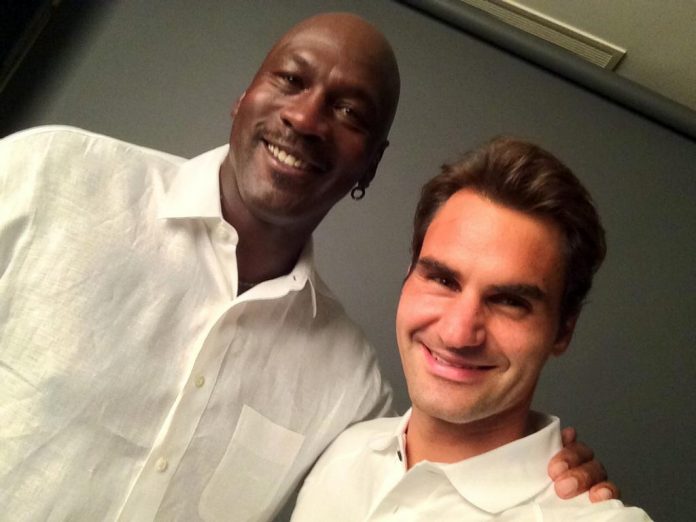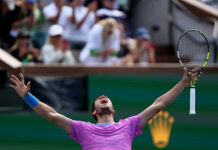A Tale of Two Geniuses – Air Jordan and the Fed Express
Bill Simons
They both did their best work in sneakers – Nike sneakers.
One was a man who traveled the globe and transformed an individual sport. The other played a team game and, although based in Chicago, changed playgrounds and sporting mindsets everywhere. One was, and the other remains, an athletic genius. Both packed huge arenas and inspired awe around the world.
Roger Federer defied gravity with grace – such balletic ease. Michael Jordan shot into orbit with astonishing, acrobatic leaps that stretched belief.
One emerged from the cool shadows of the Alps – a Mozart of the courts who told us, “Joy is the key thing for me” and went on to become a beloved international ambassador. One over-the-top Australian broadcaster gushed, “Roger’s as perfect a human being as you can get.”
The other was from the hardscrabble side of a gritty Carolina city who became the alpha male of all alpha males, a player whose win-at-all-costs competitiveness unleashed a relentless ferocity beyond that of any athlete who has ever performed.
Both Jordan and Federer had speed, explosiveness, grit. determination, flawless technique, a willingness to sacrifice, a sense of the moment, and genius – an uncanny, rarely duplicated knowledge of how to win. Each mastered the art of victory. With symphonic intuition they orchestrated athletic dominance. Some suggest that Roger is the finest male athlete to play an individual sport. The conventional wisdom is that Michael is the greatest athlete ever to play a team sport. These were among the brightest stars in our sporting galaxy.
Whether you referred to him as MJ, Air Jordan or even black Jesus, Michael was the ultimate “Don’t tread on me” warrior. While he sparked the mantra, “Be like Mike,” Federer’s fans shrieked: “Roger that!” and lifted signs that scolded, “Shhh! Genius at work.” The Almighty Roger told us, “Once you find that place of peace and quiet, harmony and confidence, that’s when you start playing your best.”
But there was little that was quiet about the street-savvy, trash-talking, cigar-chomping, tongue-wagging, championship-winning Michael Jordan – except his timeless serenity, when he became lost in his own reverie, his inner world of joy as he hugged an NBA championship trophy.
******
Jordan and Federer are both GOATS. But they were two very different ships passing in a sea of greatness. In 1998, Jordan at last stepped away from his beloved Bulls. A year later Roger played the first of his 79 Grand Slam tourneys.
There were no margue NBA teams in Europe, but that hardly mattered to a sports-loving Swiss boy who grew up watching a weekly NBA show. Outside tennis, young Roger idolized one man. MJ’s poster was pinned up in his room.
In 2014, dressed in what some called Wimbledon whites, Michael showed up at the US Open to hang out with Roger and watch him play. So we asked Roger, “What makes Jordan special?”
He leapt at the opportunity to explain. “His longevity,” he said. “The way he made it look easy, his will to win, wanting to be the best, delivering under pressure, being a superstar in a team sport, carrying his team for so many years.
“There are so many things he did well, and he represented the game really nicely…[When we met today] he wanted to know about tennis – how I prepare, how much I play, where I go next…You exchange ideas about your sports…Besides my tennis idols Stefan Edberg and Boris Becker, I had Jordan as my hero of all sports…He was really big on German TV. Every Sunday, they had unbelievable NBA highlights. That’s where I saw him do all his moves…He was such an incredible athlete. That’s what inspired me.”
After Jordan took in yet another Federer victory, I caught up with the great man and, like many a breathless reporter before me, had a fast-break interview with MJ as he strode down a corridor.
INSIDE TENNIS: What impresses you the most about Roger?
MJ: He’s so smooth, man. I love the way he moves on court. He’s so incredibly smooth.
IT: And how do you compare the amazing athleticism you saw on the court tonight with the fabulous athleticism of basketball?
MJ: They’re very similar.
IT: They both have a lot of quick footwork, lots of hand-eye coordination, plenty of grace?
MJ: Absolutely. They have a lot of similarities. They’re the same type of exercise. You use your body similarly in both tennis and basketball.
IT: So, Michael, allow me to ask how you did in that “Beginning Tennis” class you took as a first-semester freshman at the University of North Carolina.
MJ: Yeah, I did all right.
IT: And what about Serena, who’s about to go on court?
MJ: Oh, she’s confident – very confident.
And with that, Jordan vanished into the Players’ Lounge.
Both Jordan and Federer emerged from strong, though quite different, families. As young aspiring athletes, both were shaped by tough love. One day, Roger’s dad Robert had had enough with his temperamental son, stopped his car and tossed Roger into a snowbank.
When he was just 15, Michael had been suspended from school three times. His dad James (like Bjorn Borg’s parents) sat him down and made it crystal clear that if he continued his mischievous ways, he would not be allowed to play sports. Michael got it. Less than three years later he would have “A star is born” breakout moment like few others. As a 19-year-old North Carolina freshman he drained a buzzer-beater jump shot to give his Tarheels the 1982 NCAA championship.
Nineteen years later, when Roger was also a relatively unknown 19-year-old, he too had an astonishing breakout moment. At Wimbledon, the wannabe unceremoniously dethroned the seven-time champ Pete Sampras in the fourth round. Two years later, he prevailed. Soon there would be a new king of the lawns. Writer Richard Evans noted, “Federer looks so relaxed on a tennis court. He strolls around like it’s his back garden.”
Jordan’s back garden was his favorite arena – Madison Square Garden. Early on, he signed up with agent David Falk, a show-me-the-money agent in the pioneering tennis marketing firm ProServ that represented Arthur Ashe, Jimmy Connors and Stan Smith. Falk’s man Michael was an unproven team sport prospect who was emerging in an era when Converse ruled. Jordan liked Adidas, but Falk defied conventional wisdom. He marketed his man like a tennis player and signed MJ with upstart Nike for a then mind-boggling $250,000, with the understanding that the kid would have his own shoe line. Nike would soon sell $260 million worth of Air Jordans a year. Every kid, from Watts to Scarsdale, craved a pair.
Years later, Federer too would have his own Nike line. Fans beamed as they showed off their stylish “RF” gear. The icon, who after 20 years left Nike for Uniqlo for a cool $300 million, confided that being a tennis player is like running your own business. In contrast, early in Jordan’s career, the Bulls’ controversial GM Jerry Krause (everyone’s favorite NBA villain) informed Jordan, “You’re going to do what we say. You’re our property.” That’s when Jordan realized he was in a business. Their business.
Unlike some African-American superstars – the Williams sisters, Mohammad Ali, Arthur Ashe and Kareem Abdul-Jabar for example – MJ steered clear of social issues. Pete Sampras famously said he was “just a tennis player, nothing more, nothing less.” Similarly, Jordan didn’t see himself as an activist. He explained, “My game did the talking.” He wouldn’t publicly support an African-American running for Senate in his home state of North Carolina. And his quip, “Republicans buy sneakers too,” upset many. USC’s Todd Boyd complained, “That sounds as if Michael is saying, ‘My personal wealth is more important than my politics as it pertains to race.’”
Martina Navratilova was unsparing: “Have you ever seen Michael make a statement about anything? Have you seen Tiger Woods make a statement about anything? No, because they want to be marketable to everybody.”
Federer is often cautious in the public arena. But his energetic and heartfelt work to educate children in southern Africa has drawn widespread praise and helped countless kids.
The duo’s common ground is remarkable. Even though Jordan once wore his shorts backwards, he and Roger are both impeccably metro chic dressers. Both trained relentlessly and tirelessly pushed their limits. What other athletes have had greater work ethics? Rarely satisfied, they both sought to bend time. And they generously taught others, too. Kobe Bryant and Alexander Zverev gained mightily from their mentors. When Federer’s Laver Cup was played at “the house that Jordan built” – Chicago’s United Center – Nick Krygios said Jordan was the greatest. “He’s the reason LeBron, Kobe and all the top players do what they do…He’s paved the way. As tennis players, we know how special he was and how special this building is. He’s bigger than basketball. It’s a dream for me to play here. I look up and see the banners…You get good vibes.”
Jordan and Federer are macho men, but amazingly they also revealed their vulnerability. Whether as a boy or an elder, no one cries more in tennis than the weepy Federer. But there have been few more heart-wrenching moments in sports than on Father’s Day in 1996, when, three years after his father’s murder, Jordan led the Bulls to their fourth NBA championship. The still grief-stricken victor told the world, “This one’s for Daddy.” Then he retreated to the locker room, sobbing uncontrollably on the floor, his chest heaving, his emotions raw, his sorrow deep.
Each man had to overcome the sudden loss of a critical guide. In Canada in 2002, when young Roger was just 20, he learned that his formative coach, role model and father figure Peter Carter had died in a car accident in South Africa. The man-child was devastated. Sobbing in dismay, he roamed alone through the Toronto night. He felt guilty. He’d been the one to suggest Peter visit South Africa. Carter’s passing prompted Roger to put his career in a whole new perspective. To this day, Federer brings Carter’s Aussie family to the Australian Open in style.
Few other stars have been closer to their dads than Jordan was. And when James Jordan was murdered in an unimaginably senseless late-night robbery, MJ was subsumed in a soul-shaking nightmare. Soon after, Jordan briefly retired to try his other love, baseball. It didn’t work.
What worked was playing on the greatest basketball team that has ever been assembled – the 1992 Olympic Dream Team that won gold. In contrast, Federer has never won a singles Olympic Gold Medal. But his innovative Laver Cup annually draws together some of the most star-studded dream teams ever assembled. And ultimately, few stars have had as smooth sailing as Roger. Neil Harman asked, “Has there ever been a more contented champion [than Federer]?” Pam Shriver joked, “Watching Federer warm up is like doing yoga. I feel relaxed already.”
Unlike Jordan, no one ever dissed Roger for excessive gambling or untimely visits to casinos. While Jordan‘s early personal life was shaken by tumult, supposed indiscretions, false accusations and a costly and messy divorce, Roger’s marriage has seemingly been a fairytale success story.
Like Jordan, Roger continually found a way to navigate a path to victory. From the days of Agassi, Safin, Roddick and Hewitt to Tsitsipas and Zverev, he demolished foes with what Sue Mott called a “gasp inducing precision.” At times he offered some mild trash talk. When asked whether he thought Hewitt, who often lost to him, would change his tactics, Federer quipped, “He could, but then again, he could run into the knife more brutally.” But as John McEnroe noted, “Roger could shove a pie in someone’s face and they would still love him in the locker room.” James Blake mused, “You go out there, he beats the crap out of you, you come back in the locker room and he’s one of the guys.” Roger even has a benign relationship with his chief rival, Rafa “the Bull” Nadal.
In contrast, Jordan was the Bull who took no bull. He charged at all the red flags he saw waving about him. Some joked that the way to beat Roger was to bore him to death. With MJ, you never wanted to piss him off. The smallest slight, whether real or imagined, lit a fuse. It didn’t matter whether it was a feisty rival (Isiah Thomas), a future teammate (Toni Kukoc), a former teammate (BJ Reynolds) a socially inept rival coach (George Karl), a local writer, a national magazine or anyone. Like Serena, vengeance was a tonic for MJ. As with McEnroe, rage fueled his fire. Not feisty Pete Rose, Jimmy Connors, Monica Seles, Serena or even Rafa could match Jordan’s relentless ferocity. Every day, every practice, every game was a war. His drive, while golfing, playing cards, or in the NBA finals was a singular force. Ferocity was his thing. Magic Johnson recalled, “Michael didn’t want anyone to have anything.” The Laker told the Bull, “You don’t want to beat me, you want to crush me.”
While legions adored Jordan, many feared him. Everyone knew: Don’t mess with Mike! And don’t you dare step on Superman’s cape. This superhero punched his teammates, elbowed his foes, and more than anything drove himself while lifting his team. And he won.
On ESPN’s celebrated docuseries “The Last Dance” Jordan conceded, “Winning has a price and leadership has a price…I challenged people when they didn’t want to be challenged. And I earned that right because my teammates came after me. They didn’t endure all the things I endured. Once you join the team, you live at a certain standard and I wasn’t going to take anything less. If that means I have to go out and get in your ass a little bit, then I did that.”
MJ noted that he never asked people to do anything “I didn’t f—king do. When people see this, they may say…’He may have been a tyrant.’ Well that’s you. Because you never won anything. I wanted to win, but I wanted them [my teammates] to win as well…That was my mentality.”
In the end, perhaps former Chicago Bull BJ Armstrong best appreciated a thread that wove together the careers of Roger and Michael. He said that Jordan “just figured out the game. He knew how to stay in the moment. He knew how to get guys going. He not only had good offense, he was just as good on defense. He was just playing a different game than the rest of us. He let us play – but he was there to win. Once he figured that out, you couldn’t beat him.”
Federer watchers can easily relate. Coach Steve Stefanki said, “Roger never looks like he’s imposing his will…He’s playing off the music of his opponent.” A frustrated Nicolas Kiefer admitted, “We are on earth, Roger plays on another planet.” Andy Roddick claimed that Federer “didn’t miss a ball at a crucial moment for six years against me…[and is] probably the most talented player ever to carry a racket. The shots he comes up with, the way he’s become a totally complete player…and off the court Roger is just classy. He’s never high and mighty…He treats people with respect, even if it’s the locker room attendants.”
Yes, Federer’s astounding, sometimes silky, path differed from Michael’s earth-rattling road. The London Times’ Simon Barnes struck a graceful note: “Federer seeks only to defeat other tennis players, but to do so in a way that avoids beauty is beyond him.” Breathless elegance draws appreciative Wimbledon applause. But MJ is different. It’s gut-burning ambition that gets you NBA trophies – six of them.



















